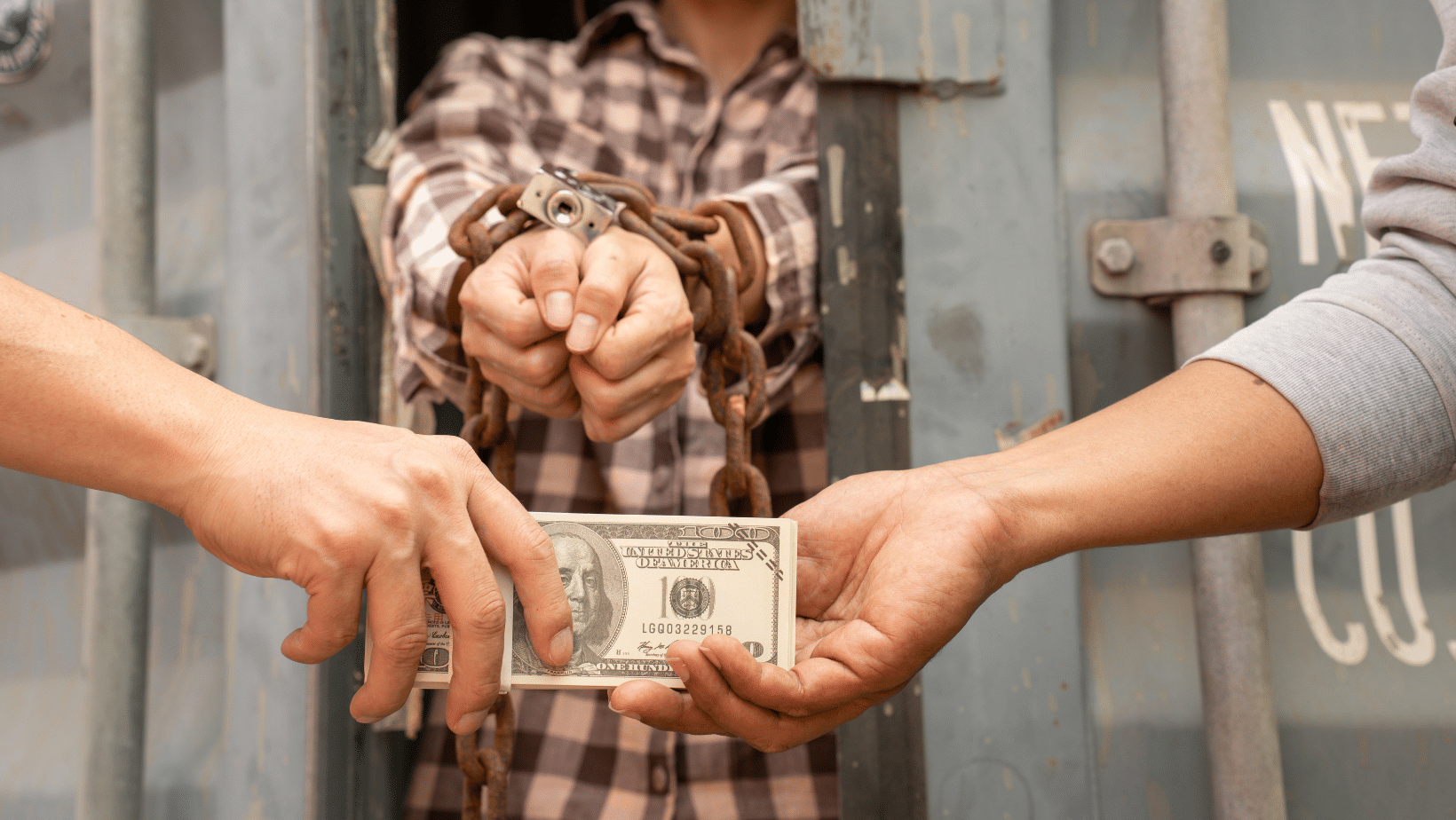
This is by far the most comprehensive mapping of sex trafficking cases worldwide ever made. We spent 6 months doing an in-depth report about worldwide trafficking. We’ve gathered data from 172 countries and analyzed 109,216 identified victims. This is by far the largest study and most on the topic.
Key Findings
- 35-40 million is every single day victims of sex trafficking
Estimates show that, internationally, only about .04% of survivors of trafficking cases are identified, meaning that the majority of cases go undetected. - In 2016 it was only: 7,572 reported hotline cases in the US
Hotline cases stand for 26% of the total cases - The average age of trafficking victims is 12-14 years old
- 79% of all human trafficking is sexual exploitation (categorized as sex trafficking)
- The “industry” has never been larger – It has an estimated 99 billion $ market value
To put it into perspective the sex trafficking industry is larger than the global cocaine market and almost as big as the global PC market. Also if you aggregated the yearly revenue of McDonald’s, Netflix, Wall Disney, and Best Buy we have the same value. - During the pandemic, online recruitment increased by 22%
The analysis found significant growth in the proportion of potential victims for whom Facebook (120% increase) and Instagram (95% increase) were the sites for recruitment. - California is the state in the US with the most victims (1,507)
- Almost 20-30% of all victims are children (1 out of 4)
Worldwide, there have never been so many child victims (around 100.000). In some parts of Africa and the Mekong region, children are the majority (up to 100%). - Why people end up in sex trafficking; Recent migration, Mental Health issues, Unstable housing, Homeless Youth, and Drug abuse
Everyone ending up in a trafficking situation has a clear and identifiable vulnerability that a trafficker prey upon. - Human trafficking is usually violent
Most traffickers use psychological means such as tricking, defrauding, manipulating, or threatening victims into providing commercial sex - The majority have been trafficked by people who know
It’s 60% who know their offender. - LGBTQ persons have a higher chance of being victims of trafficking
Especially women and girls. - Migrant, native, and non-English speaking populations were found to be the most vulnerable
- There are more than 150,000 escort ads posted online every day (many of them are trafficking-related)
Data and methodology
- Data/information was collected from 172 countries with 109,216 identified victims.
- From the year 2003 – 2023.
- Estimating the full overview of trafficking is challenging since victims so often go undetected, something the United Nations refers to as “the hidden figure of crime”.
- To support the findings of this report, external sources have been used as peer review tools.
- Sex trafficking is defined as “the range of activities involved when a trafficker uses force, fraud, or coercion to compel another person to engage in a commercial sex act”.
- It has been easier to gather data on certain regions/countries than others (which therefore can result in a minor distortion of the real picture).
The results of the analysis
Human trafficking is divided into forced labor and sex trafficking. We’ve chosen to primarily focus on sex trafficking since this stands for 79% of all human trafficking cases in the world. This detailed-oriented approach makes room for insights that map sex trafficking from an angle never seen before.
Lean back and prepare for the news that is happening right now while you’re reading this report.
Countries analyzed in this research

Understanding the Global Landscape of Sex Trafficking
Before diving deep into the statistics and intricacies of sex trafficking, it’s essential to grasp the broader picture of this global crisis. Sex trafficking isn’t confined to specific regions or countries; it’s a pervasive issue that transcends borders, cultures, and socio-economic classes. By understanding its global prevalence, we can better appreciate the magnitude of the challenge we face and the urgency to address it. The following sections will provide a comprehensive overview of sex trafficking across different regions, shedding light on the most affected areas and the unique challenges each region faces. Let’s embark on this journey to uncover the truths hidden behind the numbers and better equip ourselves to fight against this modern-day slavery.
1) Global overview
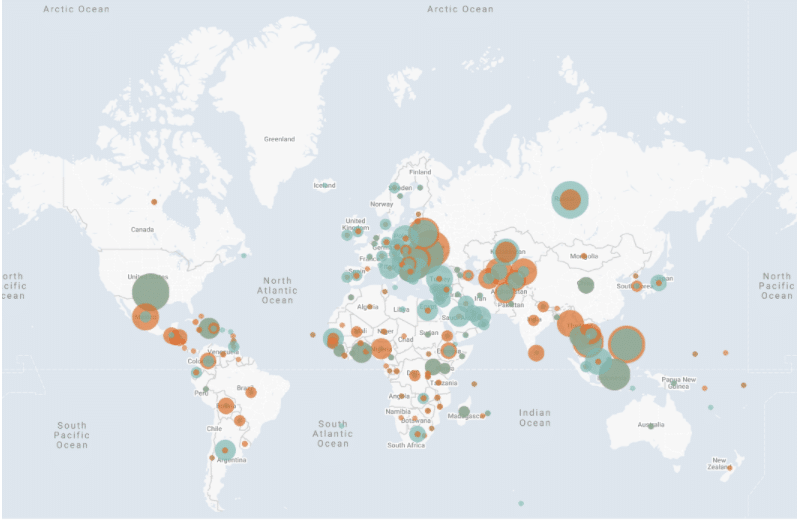
- There are conservatively 35 million that daily are victims of sex trafficking. The above heatmap illustrates where in the world we’re observing the most activity.
- The orange circles us, that a significant part of the victims of sex trafficking come from East Europe (Ukraine, Belarus, Moldovia, and Romania), Asia (Burma, Thailand, Cambodia, Vietnam, and the Philippines), West Africa (Nigeria, Cameroon, Ivory Coast, and Sierra Leona), and Middle America (Mexico, Colombia, Honduras, Guatemala, and Jamaica).
- The green circles are where sexual exploitation is taking place. Here are countries in North- and West Europe together with the USA and Asia leading areas. Especially countries like Poland, Turkey, the Philippines, Thailand, Cambodia, The Emirates, the USA, and Argentina.
2) Regional overview
If we dig deeper into the data we can see some interesting results in the regional areas.
2.1) Northern America
- USA, Canada, and Greenland
52.36% of the world’s sex trafficking victims are happening in Northern America, and 84% of the sexual exploitation is females, 15% males, and 1% transgender. Looking further into the age and allocation between adults and children we’ve found the following. In other words, it’s around 10,583 victims in northern America.

2.2) Central America
- Mexico, Guatemala, Honduras, Nicaragua, Costa Rica, Panama, Cuba, and the Caribbean islands
Less than 0.5% of the total number of sex trafficking cases happens here. 65% of females and 35% of males are the victim distribution.
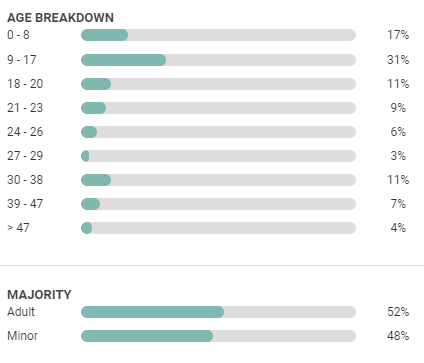
2.3) South America
- Argentina, Brazil, Uruguay, Paraguay, Bolivia, Peru, Ecuador, Colombia, Venezuela, Guyana, and Surinam.
0.92% of the total amount of victims comes from South America, and looking at the sex distribution we can see that; 72% of the victims are females, 28% males, and 0% transgender. The age- and majority allocation can be seen here:
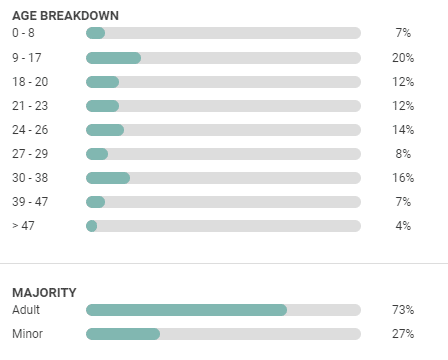
2.4) Northern Europe
- Norway, Denmark, Sweden, Finland, Great Britain, Iceland, Estonia, Latvia, and Lithuania.
0.81% of the victims happen in this region. But compared to other regions the gender ratio is a bit different. 58% are females, 41% are males, and 1% are transgender. Breaking it further down to age and majority, the data shows the following:
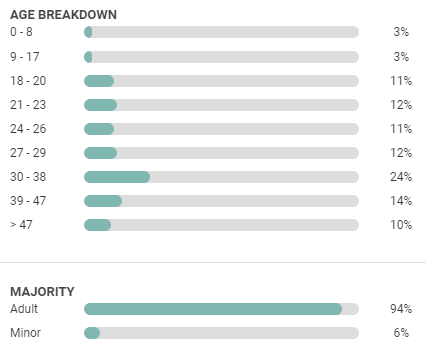
2.5) Western Europe
- France, Germany, Belgium, Austria, Switzerland, Netherlands, Luxembourg, and Monaco.
Kind of the same story for Western Europe as the Northern part. 1.09% of the total number of sex trafficking is going on in countries such as France, Spain, and Portugal. 78% of victims are females and only 22% are males. The pictures are also intact as regards the age- and majority distribution:
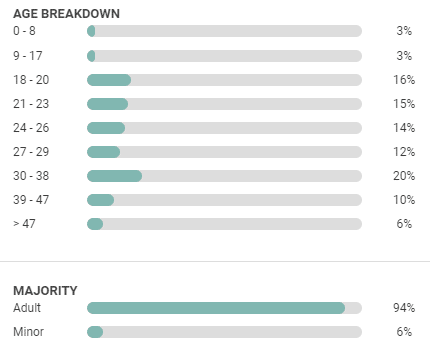
2.6) Eastern Europe
- Russia, Poland, Ukraine, Romania, Bulgaria, Belarus, Hungary, Czech Republic, and Slovakia.
Eastern Europe stands for 14.07% of the victims, and the gender distribution is a bit more aligned than we saw in Northern Europe. 53% of the victims are females, 47% in males, and 0% as transgender.
Looking into the age distribution we can see that especially the 30-38-year-olds have a mentionable part of the victims in this area:
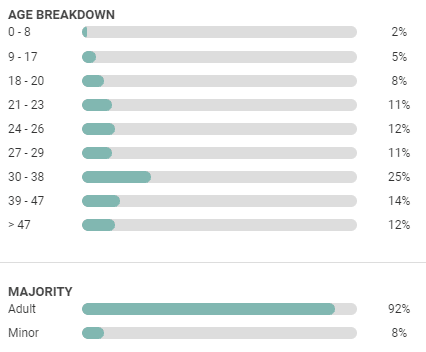
2.7) Southern Europe
- Portugal, Spain, Italy, Croatia, Serbia, Greece, Albania, Macedonia, Kosovo, and Montenegro.
Compared to the other European regions. The Southern has more cases of identified sex trafficking victims. Even though it’s a minor part compared to Northern America, it’s still x3 more than the other European regions. We see that 3.13% of the sex trafficking is happening here. And this region is also dominated by female victims (88%), and a minor amount of male victims (12%).
There are not many child cases. It represents 11% of the crime and the rest is adult victims (89%).
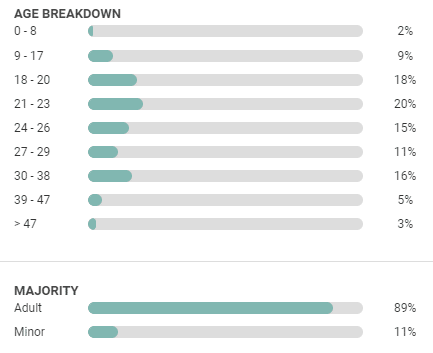
2.8) Northern Africa
- Marocco, Algeria, Tunisia, Western Sahara, Libya, Egypt, and Sudan.
Here is 2.68% of the sex trafficking occurring. 57% are females, 43% are males, and 0% are transgender. Like most regions, the majority are adult victims:
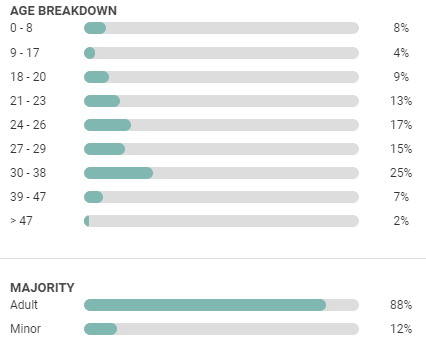
2.9) Central Africa
- Cameroon, Central African Republic, Chad, Congo Republic – Brazzaville, Democratic Republic of Congo, Equatorial Guinea, Gabon, and São Tomé & Principe
We don’t have that much data from this area. So it’s only 0.5% of the total amount of victims that we’ve been able to capture from this area. 67% are females and 33% are males. More interesting is that out of all cases, child sex trafficking happens in 47%. That’s a really big portion and the biggest in all regions of the world.
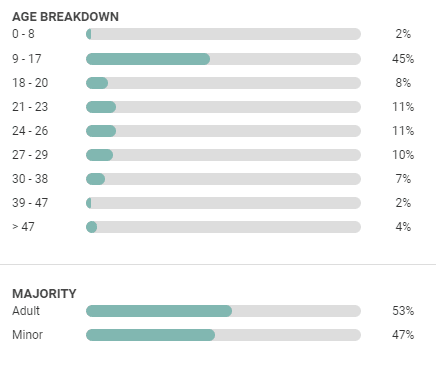
2.10) Western Africa
- Benin, Burkina Faso, Cape Verde, Côte D’Ivoire, Gambia, Ghana, Guinea, Guinea-Bissau, Liberia, Mali, Mauritania, Niger, Nigeria, Senegal, Sierra Leone, and Togo
In Western Africa, 2.81 percent identified as victims out of the total amount for the whole world. It has 63% females and 37% males, and like Middle Africa, it has relatively many child victims compared to the rest of the world.
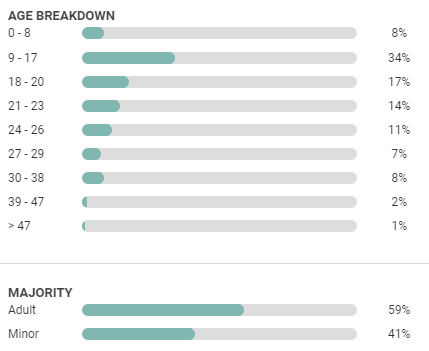
2.11) Eastern Africa
- Burundi, Comoros, Djibouti, Eritrea, Ethiopia, Kenya, Madagascar, Malawi, Mauritius, Réunion, Rwanda, Seychelles, Somalia, Somaliland, Tanzania, and Uganda
Eastern Africa has 1.45% victims out of 100%, and it is distributed with 65% females and 35% males. Looking further into the age we find that the 9-17 years old are the age group with the most identified victims. This region also has a high amount of child sex trafficking cases.
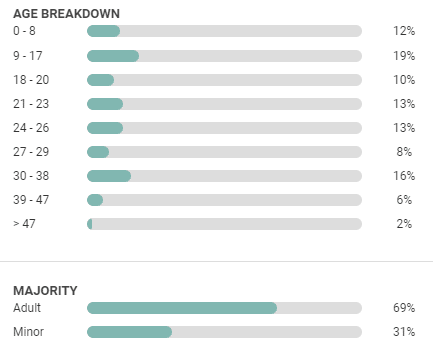
2.12) Southern Africa
- Angola, Botswana, Lesotho, Mozambique, Namibia, South Africa, Swaziland, Zambia, and Zimbabwe
This region stands for less than 0.5% of the total victims in the world. There are registered 61% female cases and 39% male cases. As regards the age breakdown and majority distribution it’s quite similar to Northern Africa.
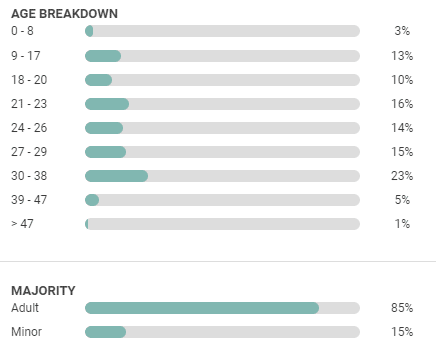
2.13) Western Asia
- Bahrain, Iraq, Jordan, Kuwait, Lebanon, Oman, the State of Palestine, Qatar, Saudi Arabia, the Syrian Arab Republic, the United Arab Emirates, and Yemen
5.98% of the total sex trafficking is going on in Western Asia, and here are the females especially vulnerable (90%) compared to males (10%). It’s the region with the fewest child trafficking cases (3%).
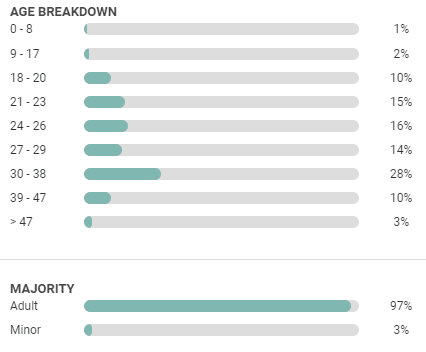
2.14) Central Asia
- Kazakhstan, Kyrgyz Republic, Tajikistan, Turkmenistan, and Uzbekistan
2.62% of the trafficking cases come from Central Asia, and it has like the European regions almost an equal-weighted distribution between female and male cases (51% to 49%).
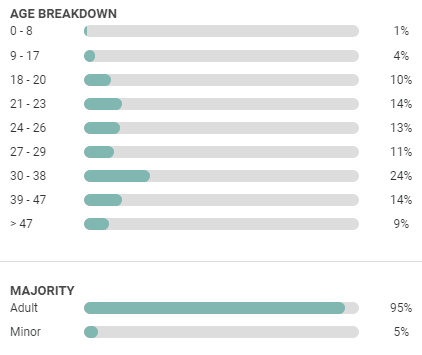
2.15) Southern Asia
- Bangladesh, Bhutan, India, Pakistan, Nepal, Sri Lanka, and Afghanistan
1.02% of the sex trafficking victims happen in this region. 58% are females and 42% are males. More interesting is that almost 41% of the victims are between 9-17 years old.
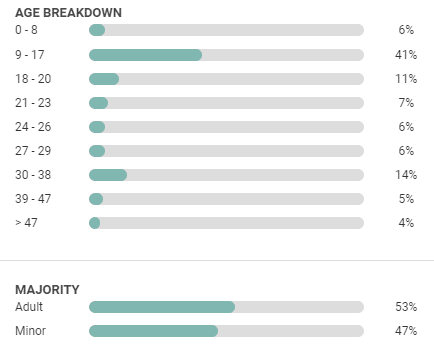
2.16) Eastern Asia
- China, Hong Kong, Japan, Macau, Mongolia, North Korea, South Korea, and Taiwan
1.29% of the identified victims occur in Eastern Asia. 86% are females and 14% are males. Compared to Southern Asia there are not many child victims.
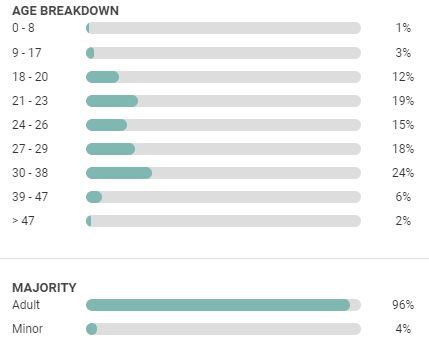
2.17) Southern-Eastern Asia
- Brunei, Burma (Myanmar), Cambodia, Timor-Leste, Indonesia, Laos, Malaysia, Philippines, Singapore, Thailand, and Vietnam
7.97 % of the total amount of victims is happening in Southeast Asia. That’s a pretty big portion compared to how many people live there. Of the many victims, 54% are females and 46% are males.
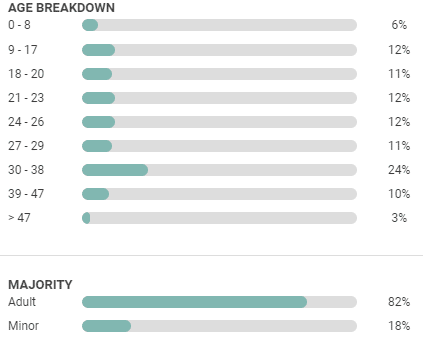
2.18) Australia and New Zealand
- Australia and New Zealand
Australia and New Zealand are recognized for their less than 0.5% victims and the fact that it’s the only region with more male victims (91%) than female victims (9%). And lastly, it has only adult cases.
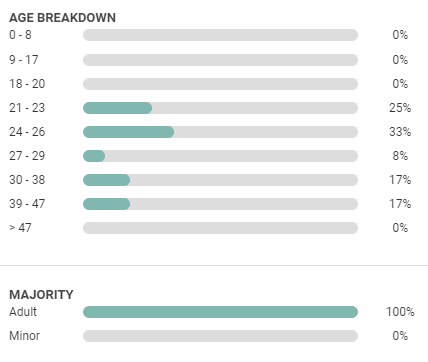
3) Sub-conclusion to global- and regional overview
The above global- and regional overview gives some interesting insights:
- Africa and Southern Asia have many child sex trafficking cases (Around 50% of all cases are with children)
- Over 50% of the world’s sex trafficking happens in the US
- Females are more frequently victims of sex trafficking than men. We do see that it depends a bit on the region. E.g. European countries are close to 50/50, and in Australia and New Zealand, males are more exposed.
- The age distribution shows that 30-38-year-olds are most likely victims of sex trafficking all around the world.
4) Sex trafficking USA; the country where it happens
Since the USA is the area where most of the sex trafficking cases are taking place, we’ve together Neal Davis Law Firm looked into how the distribution is between the states. And as you can see Texas and California are having really many cases.
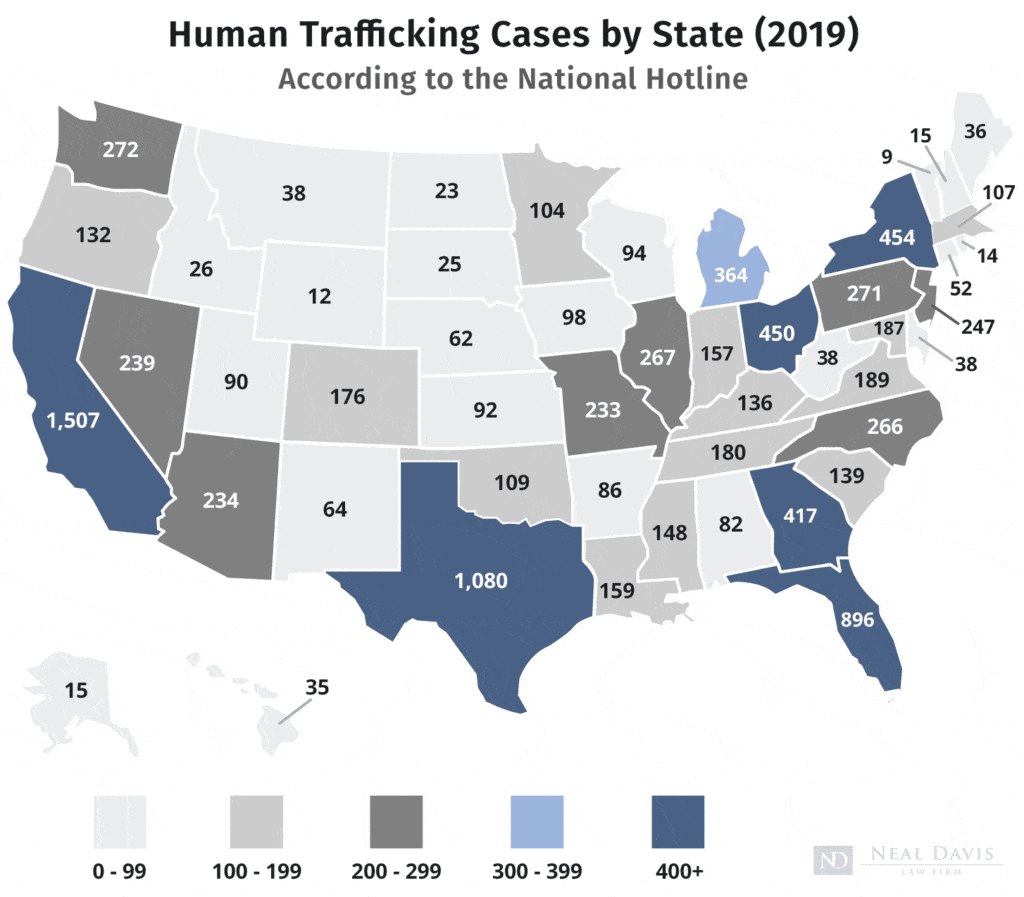
5) The development of the industry
There is no doubt that the industry is expanding and developing with the world. We see that in different ways e.g. that online recruitment is an increasing method during the pandemic (much more about this later on).
Sexual exploitation has an estimated market value of 99 billion dollars. Which means that it’s bigger than the global cocaine market. Also, it’s almost as big as the total global PC market. In other words, we have an industry that is really big. And it does not seem like it’ll stagnate in the coming years.
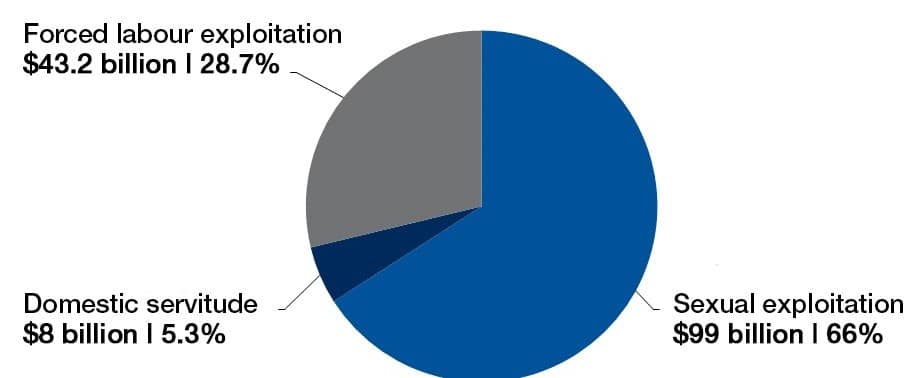
So why is sex trafficking practiced, when people know it’s illegal?
Sex traffic is primarily a money game. A lot of the victims do not enter this industry by their own choice. Its often because they are in a vulnerable time in their life where they meet people that take advantage of that situation. Sadly, data shows, that they are highly underpaid compared to the service they charge. Further, a lot of them are from poor environments where the masterminds pay families around 800$ to 2000$ for a daughter. Which is juxtaposed to a whole year’s income for many families in those areas.
6) Sex trafficking is a profitable business (Exclusive insights)
The average annual profit for every woman in sex trafficking is 100.000$. The average for both genders is 21.800$. Further, the report reveals that sexual exploitation can yield a return on investment ranging from 100% to 1,000%. In the Netherlands, investigators were able to calculate the profit generated by two sex traffickers from a number of victims. One trafficker earned $18,148 per month from four victims (for a total of $127,036) while the second trafficker earned $295,786 in the 14 months that three women were sexually exploited.
7) Worldwide: Identified victims vs. estimated victims
There is a huge difference between the estimated number of victims and the identified victims. The identified victims are the cases that go to the police and often to court. But we know from research that the majority do not end there. It’s under 5% that is prosecuted.
That being said the identified victims’ statistics give a good idea about the development. So as you can see the cases are increasing significantly, and so are the earnings. Since 2014 we’ve seen a 60% increase in identified victims.
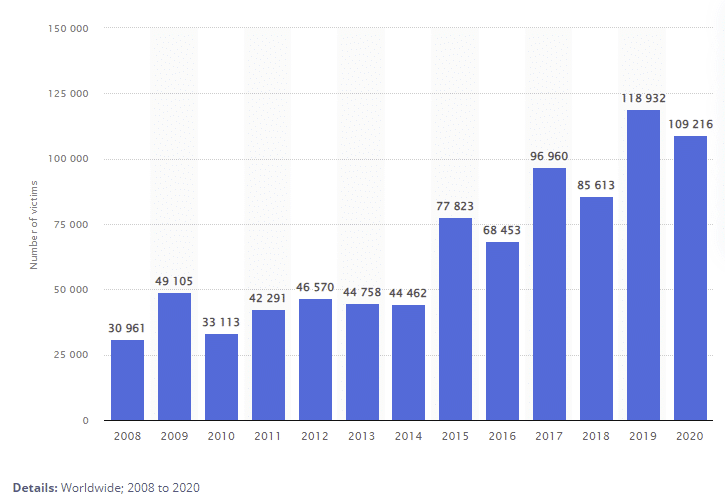
8) The pandemic’s impact
During the lockdowns, as the proportion of victims from common recruitment sites such as strip clubs (-46%), foster homes (-70%), and schools (-38%) went down drastically, the Internet was reported as the top recruitment location for all forms of trafficking.
Most notably, the analysis found a significant increase in the proportion of potential victims for whom Facebook and Instagram were the sites for recruitment into trafficking (120%)

125% increase in reports of recruitment on Facebook over the previous year.

95% increase in reports of recruitment on Instagram over the previous year.
Experts are afraid that the pandemic has increased the number of sex trafficking cases/victims. It seems like the organizers have been more direct in their communication with the victims. This is due to the increased challenges that the pandemic has given rise to.
“Trafficking in Texas has e.g. risen during the COVID-19 pandemic. That’s because economic problems caused by the pandemic have made the problem of human trafficking worse”
– Samantha Hernandez, Mobilization Director for Elijah Rising
The director for UNODC follows up:
“The pandemic has increased vulnerabilities to trafficking in persons while making trafficking even harder to detect and leaving victims struggling to obtain help and access to justice”
-Ghada Waly, Executive Director UNODC
9) Most common venue for sex traffickers
When a sex trafficker is placed in a country it’s quite different were and what they do. It mostly depends on factors such as Gender, Location, and Age. A random sample shows that the majority goes into Escort Services, Pornography, and the Illicit massage/Spa business.

10) Risk factors
There are different reasons why people end up in sex trafficking. The most commons are:
- Abusing drugs
- Runaway/Homeless youth
- Unstable housing
- Mental Health Concern
- Recent Migration/Relocation
People within these circumstances are more vulnerable to getting “targeted”.
The peoples who’re hiring the victims are:
- Intimate partners (38%)
- Family (27.1%)
- Other (21.3%)
- Friend (14.6%)
About the Researchers
This report was conducted by the Bedbible research center. The report is one of the most exhaustive on the topic with data across nations. The research was funded by Bedbible.com; a brand that helps visitors find sex toy products in an unbiased way, and further do in-depth research on the topics of romantics and erotics. Bedbible.com has no ads and is free to use for everyone.
